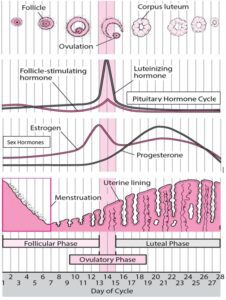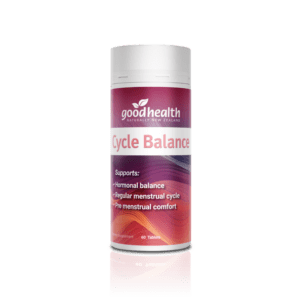
In honour of the release of our Women’s Health Range, the Good Health naturopath team has put together a series of health articles taking a deep dive into the wonderful, complex world of the 3 Ms—menarche, menstruation, and menopause. We will also explore the female hormonal lifecycle and microbiome, potential issues that can arise, what happens and where, and some ancestral tips on how to support what is uniquely female.
Part 2 – Menstruation
It is hard to go past the fact that in the majority of societies menstruation is considered a taboo subject, with women being made to feel dirty or even dangerous because of it. Primitive beliefs ranged from anxiety about bacterial spread to worries that the smell of blood interfered with the hunting of animals. The traditional cultures that treat women with respect during that time are few and far between. In the West, we have come a long way, yet there is still a perception that women are less “reliable” and “volatile” prior to or during menstruation, which is not a particularly accurate or productive paradigm.
There is also a perception that women who live in close quarters tend to sync with each other and menstruate at the same time each month. Whether or not this is an actual phenomenon, some cultures choose to enact rituals around their periods, describing that time as having heightened spirituality and connectedness. Whichever way you feel about your monthly cycle, it is important to know what is going on—what should be happening and what shouldn’t be—so that you can be empowered to look after your own health, know when to seek professional advice, and learn to embrace it as the very special and unique thing it is.

The Main Reproductive Hormones and the Cycle
Reproductive hormones are steroid hormones and pregnenolone is the cholesterol-derived precursor for all reproductive hormones.
> Oestrogen is not a single hormone but a group of hormones, known as the oestrogens. These are made through aromatising androgens with aromatase (oestrogen synthase) in various tissues, including gonads (ovaries), brain, adipose tissue, placenta, blood vessels, skin, bone, and adrenals. The oestrogens, to varying degrees, stimulate the development of breast and reproductive organs and ensure their function. Their main function is to stimulate the growth of tissue but do so in a way that must be tightly regulated.
The three main forms are: Oestradiol (E2), the most potent form made by the ovaries, adrenals, and fat cells when older; Oestrone (E1), the primary oestrogen after menopause, produced mostly by fat cells and adrenals (some estrone is made in the ovaries during the reproductive years); and Oestriol (E3), the weakest and least active form of oestrogen, primarily functioning during pregnancy. Another oestrogen, called oestetrol (E4), is produced only during pregnancy.
There are three main oestrogen metabolites via the liver: 2-hydroxy estrone (2-OHE1), 16-hydroxy estrone (16-OHE1), and 4-hydroxy estrone (4-OHE1). 2-OHE1 is considered the safest and weakest metabolite. 4-OHE1 and 16-OHE1 are much stronger and have been associated with damage to reproductive tissue and the brain. Poor diet, alcohol consumption, pesticide use, smoking, obesity, etc., are associated with higher circulating levels of 4 and 16-OHE1.
> Progesterone is more often than not relegated to being the second most important “female hormone,” but its relevance is much wider and more important than that. Progesterone is made primarily by the ovaries, but the adrenal glands, peripheral nerves, and brain cells do contribute. Progesterone ensures the development and function of the breasts and female reproductive tract. It helps to stimulate the growth of the uterine lining, the endometrium. In the brain, progesterone exerts a calming effect and supports sleep. Progesterone supports insulin sensitivity, metabolism, and thyroid hormone function; bone building; the cardiovascular system; and libido. Progesterone antagonises oestrogens (and cortisol) and keeps them in check, particularly during pregnancy.
> Surprisingly, the androgen, Testosterone, is the most abundant reproductive hormone in women, but men have it in much higher quantities. It supports libido, sleep, the heart, and brain function; strengthens ligaments; builds muscle and bone; and is associated with confidence and stamina.
> Dehydroepiandrosterone (DHEA) is made primarily by the ovaries and adrenal gland, but the skin and brain contribute. DHEA is the most abundant circulating hormone, and it protects against stress effects and supports libido, motivation, immune health, sleep, and mental clarity. DHEA can be converted into oestrogens and testosterone in fat, muscle, bone, and liver tissue.
Simply put, the menstrual cycle is regulated by the hypothalamic-pituitary-gonadal (HPG) axis and the hormone leptin. In the brain, the hypothalamus releases gonadotropin-releasing hormone (GnRH) into the anterior pituitary, leading to the production and secretion of the gonadotropins, including luteinizing hormone (LH) and follicle-stimulating hormone (FSH). LH and FSH act on the female gonads (ovaries) to stimulate ovulation (LH) and the conversion of androgens in the ovaries to estradiol (FSH).
Incidentally, both men and women produce the same hormones, but their production sites, tissue and blood concentrations, and interactions with organ systems are different.
The Female Menstrual Cycle
The female menstrual cycle (see graphic) is a cascade of pituitary and ovarian hormones influencing the growth or breakdown of reproductive tissue in the ovaries, uterus, and breasts. The duration of the complete cycle is usually around 28 days but can vary between 21-35 days, which is considered “normal.” The cycle starts with the first day of menstruation—the period—and finishes on the day prior to menstruation.
In the middle of the cycle, during ovulation, an egg is released from an ovarian follicle. Sometimes more than 1 egg is released. After ovulation, the mature egg is ready to be fertilized by sperm during intercourse, which usually results in conception and a pregnancy. If an egg remains unfertilised, it will still travel to the uterus where the endometrial lining has been building up over the prior 21ish days. Menstruation is simply the shedding of an unfertilised egg along with the unwanted endometrial tissue.
Graphic – The Menstrual Cycle

How Do I Know If I Am Ovulating?
There are signs that you can look for and measure:
- Changes in basal body temperature (BBT) – Your BBT is your lowest daily body temperature, which you can measure upon waking each morning. On the day after you ovulate, your BBT will go up (perhaps after dipping slightly) between approximately 0.22 and 0.56 degrees Celsius and stay elevated until you menstruate. Your most fertile period is the two to three days before the increase in BBT. You’ll need a special basal body thermometer, available from most pharmacies, and you can identify patterns by charting monthly temperature changes for a few months.
- Changes in cervical mucus: 5-6 days prior to, and 2-3 days after, ovulation, you may notice an increase and change in cervical mucus. To help sperm swim towards an egg, this mucus becomes like raw egg white—stretchy, clear, thin, and slippery. The potential for conception is at its peak when mucus is at its most slippery and clear.
- Changes to the cervix: If you are ovulating, your cervix will be softer, higher, wetter, and more open than usual. Your labia may be slightly swollen and more sensitive.
- Lower abdominal or back/side discomfort: This is known as mittelschmerz (German for “middle pain”). The feeling may last minutes to a day or so and can either be dull and achy or sharp.
- Spotting: Light brown or red spotting may happen all at once or for a few days and is a result of the follicle splitting open to release the egg.
- Breast tenderness: The release of hormones may make your breasts or nipples feel tender and heavy after ovulation.
- Heightened sense of smell: Some women report this, but more research is needed.
- Increased libido: Makes sense! This is the “perfect” time to procreate.
- Changes in appetite or mood: As oestrogen levels peak on ovulation, your appetite may decrease for a few days. Then, as progesterone rises prior to menstruation (or pregnancy), your appetite may increase. The release of LH and FSH during ovulation may support a good mood.
- Fluid retention: LH and oestrogen rising just before you ovulate may cause you to retain fluid and feel bloated. Then as progesterone increases, your digestion may slow down.
If you don’t ovulate, there won’t be an egg available, and you won’t be able to fall pregnant. This is known as an anovulatory cycle. You also won’t ovulate if you’re actually pregnant, postmenopausal, or on birth control (at least you are not meant to!). You may also not be able to get pregnant if you are on certain medications, have recently given birth (especially if you are exclusively breastfeeding), have a reproductive hormone imbalance, are underweight or overweight, and/or are under excess stress. Stress will play havoc with your hormones and reproductive cycle.
Reproductive Problems
In traditional Chinese practice, it is considered abnormal for a woman to experience any trouble with any part of her menstrual cycle; that a woman’s periods should come and go with as much ease as the sun rising and setting. There should be little to no mood swings, irritability, pain, spotting, breast or tummy discomfort, skin breakouts, or digestive upsets, etc., prior to menstruation, and the period should be comfortable with little to no clotting and last no more than 5-6 days. They should be relatively regular, as close to a 28-day cycle as possible. Ovulation should occur every month, and there should be no irregular or excessive bleeding or a complete absence of a monthly period. If anything about your cycle is worrying you, please see your healthcare professional.
A healthy woman of reproductive age is a fertile woman. That does not mean to say that an unhealthy woman cannot get pregnant, but we can tell a lot about the true health of a woman by her menstrual cycle. She may or may not be truly fertile or ovulating, but there will often be signs pointing to imbalance or dysfunction in her body.
Stress is a big problem for reproductive hormone balance because when we are stressed, our bodies deprioritise “nonessential” functions like reproduction, and oxidation processes can get out of control. Research has shown that constant emotional stress downregulates reproductive hormone production and/or throws them out of balance. Rampant oxidation can cause or worsen reproductive and hormonal issues. Research also shows us that reproductive hormone health is heavily influenced by our circadian rhythm—the daily, natural light and dark cycles—and its chief hormones—melatonin and cortisol, along with leptin. Leptin is an incredibly important hormone for reproductive health, and having a disrupted circadian rhythm can dysregulate leptin as well as cause major stress on the body.

Infertility is prevalent in regions of the world with high rates of blood sugar dysregulation and metabolic dysfunction. In the West, particularly the US, less than 15% of the population is thought to be metabolically healthy. Metabolic dysfunction affects reproductive physiology, including egg (oocyte) development, ovulation, and implantation. Irregular ovulation and periods, signs of testosterone imbalance, and abnormal growths are thought to be potentially caused by the metabolic inhibition of aromatase, which causes reduced oestradiol; however, there are multiple factors involved, and oestrogens can also run rampant if they are not metabolised and excreted properly by the liver and bowel or if progesterone production is too low—it is all about balance!
Hormonal Balance
A healthy liver is essential for the metabolism and management of reproductive hormones. The health of the liver is affected by the health of the body’s metabolism. It has been demonstrated that in a model of dysregulated metabolism and unhealthy liver function, high or recirculating oestrogens can stimulate the adrenal glands without pituitary involvement, leading to an increase in adrenal androgens and an increase in body hair growth and other male characteristics. Oestrogens (chiefly oestradiol, at this point) need to be produced, do their job at the right time, and then “get out of Dodge,” so to speak. Women who do not experience problems are able to metabolise oestradiol to 2-hydroxy estrone (2-OHE1) and excrete it. Recirculating or excess oestrogens and their less healthy metabolites, 16-hydroxy estrone (16-OHE1) and 4-hydroxy estrone (4-OHE1), and/or relatively low progesterone, is often called “oestrogen dominance.” This can cause a number of problems with the menstrual cycle, including premenstrual issues. An imbalance of serotonin and its associated hormones is also problematic, especially just prior to the start of menstruation. Additionally, the health of the thyroid affects reproductive function and metabolism. Nutrients that support liver and thyroid health include animal protein, choline, copper, iodine, selenium, zinc, and vitamins B1, B3, B6, A, D3, and folate. Iodine is especially important for the health of all reproductive tissue, and true vitamin A (retinol) is essential for reproductive function. See Liver Love for a Better Life for more information about liver health.
Following on from the importance of producing the right volume of oestrogens and metabolising and excreting them expediently via the liver and bowel, it appears to be just as important to ensure healthy progesterone production. Progesterone synthesis is suppressed during times of stress to prevent pregnancy because reproduction is not considered an acute, life-or-death activity, unlike running or fighting when confronted by a threat. High oestrogens and/or their metabolites, free-radical excess, high prolactin and adrenocorticotropic hormone levels, high cortisol, high levels of carotene, and an imbalance of gonadotropins can cause low progesterone. Low thyroid hormone and LDL, as well as true vitamin A (retinol) deficiency, can also prevent the synthesis of progesterone, as can certain instigators of early puberty (see the Menarche article in this series). Oestrogens can induce excitotoxic death of brain cells, and progesterone and pregnenolone are known to combat this and other consequences of unchecked oestrogens.
While we cannot fathom the true complexity of human hormonal and metabolic function, and although scientific research, especially of female endocrine (hormonal) function, is lacking, we can use our relatively limited knowledge to connect many of the dots. Our modern lifestyle—with our high, ultra-processed food diets, high stress, and exposure to pollution, chemicals, and artificial light, especially at night—is more than likely to blame for hormonal imbalance and our high rates of reproductive issues. Blue light exposure, chemical and air pollution, alcohol consumption, central adiposity, obesity, inflammation, consumption of refined sugar and seed/vegetable oils, medications, nutrient deficiencies, etc., have all been shown in research to cause or exacerbate serious metabolic dysfunction and negatively impact liver health (and other organs) with downstream effects on reproduction and hormones. Hormonal balance simply means that the ratios of hormones to other hormones are correct so that the reproductive system, and the whole body, can function as it should.
Wisdom of Ancestrally Living Humans
There are “primitive” humans, around the globe, still living close to nature, whose women do not exhibit reproductive problems. It is speculated that this is because they have healthy metabolisms due to evolutionarily consistent, ancestral lifestyle practices.

The main factors appear to be:
- a nutrient-dense, animal-based diet with no ultra processed foods
- a healthy and balanced microbiome
- deep connection to the earth, nature, and each other
- supportive social networks
- appropriate activity levels
- little to no electromagnetic, chemical, or air pollution
- lower overall stress
- enjoying creativity and learning
- no pharmaceutical medications
- daily exposure to natural light (little to no artificial light – LED/fluorescent bulbs, screens, etc.)
These lifestyle practices have been shown in scientific research to support human circadian rhythms, balanced hormonal function, sound sleep, stress management, redox potential (healthy oxidation and less free radical accumulation), and naturally high “feel good” hormones.
If you are a female at any stage of life, and you are experiencing an imbalance in reproductive hormone, affecting your quality of life, you can read more about ancestral lifestyle and dietary factors to support your hormones and metabolism, here.
Herbs have a long history of use in traditional practice and can be a wonderful support for female hormones.
Introducing: Good Health Cycle Balance
Good Health Cycle Balance is a unique blend of 6 synergistic herbs at scientifically researched doses, plus kelp (for iodine), designed to support a healthy menstrual cycle, balanced hormones, and premenstrual and period comfort. Dong quai, bupleurum, paeony, ginger, and liquorice have long been used by women of reproductive age in traditional Chinese practice, and research has shown them to support a healthy hormonal balance, blood flow, uterine tone, menstrual comfort, and liver function. A healthy liver is essential to support the metabolism of oestrogens. Cycle Balance supports the nervous and hormonal systems for healthy mood, skin, and breast comfort. The thyroid and adrenals are also supported, as they are essential for healthy reproductive function.

Cycle Balance supports:
- Hormonal balance
- Period comfort
- Regular menstrual cycle
- Premenstrual and breast comfort
- Healthy blood flow
- Liver, thyroid, and adrenal function
- Healthy mood and skin
Click the following for more in the Women’s Health Series:
The 3 Ms and the Female Hormonal Life Cycle, Part 1 – Menarche
The 3 Ms and the Female Hormonal Life Cycle, Part 3 – Menopause
Ancestral Wisdom for Female Hormonal Health, Part 1
Ancestral Wisdom for Female Hormonal Health, Part 2
TAPS No: PP2522 and PP2888
